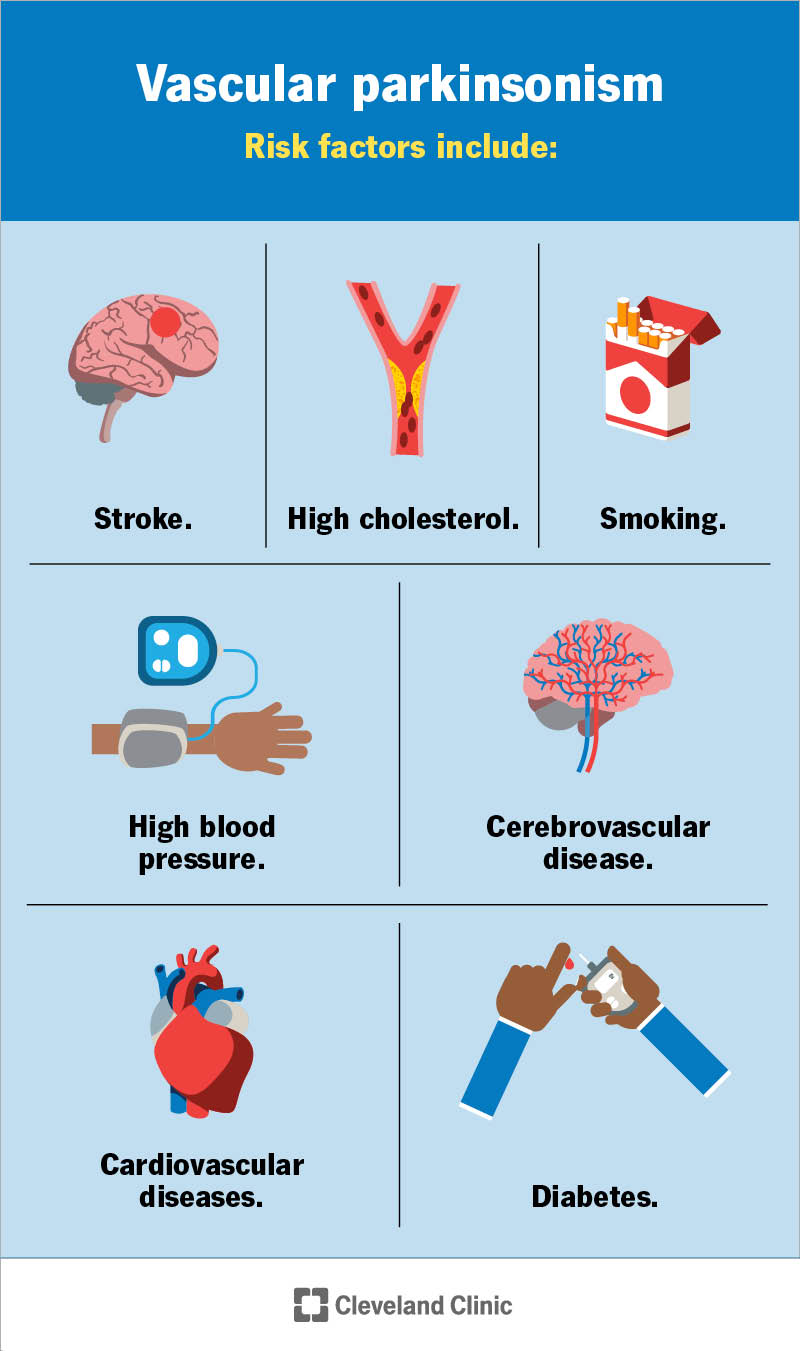Vascular parkinsonism (VP) causes walking and balance problems due to issues with blood vessels in your brain. One or multiple strokes are the primary cause. There’s no cure for VP, and treatment mainly involves managing symptoms with physical and occupational therapy.
Advertisement
Cleveland Clinic is a non-profit academic medical center. Advertising on our site helps support our mission. We do not endorse non-Cleveland Clinic products or services. Policy
Vascular parkinsonism (VP) is a condition that causes symptoms of parkinsonism due to issues with blood vessels in your brain (cerebrovascular disease). “Parkinsonism” is an umbrella term that refers to brain conditions that cause slowed movements, stiffness and tremors.
Advertisement
Cleveland Clinic is a non-profit academic medical center. Advertising on our site helps support our mission. We do not endorse non-Cleveland Clinic products or services. Policy
The movement symptoms of vascular parkinsonism typically only affect your lower body and cause unsteadiness when you walk.
Vascular parkinsonism is relatively rare. It represents 4.4% to 12% of all cases of parkinsonism. Parkinson’s disease is the most common form of parkinsonism. It ranks second among the most common age-related degenerative brain diseases.

Symptoms of vascular parkinsonism include:
Compared to other forms of parkinsonism, VP doesn’t typically cause tremors while you’re resting. It’s also not usually as responsive to the medication levodopa, a go-to treatment for Parkinson’s disease.
Other features of VP may include:
It’s important to see a healthcare provider if you’re having these symptoms.
Vascular parkinsonism develops due to blood flow issues in your brain. These may include:
Not everyone who has a stroke will develop VP. There are several different kinds of strokes. They can affect many different parts of your brain.
Advertisement
Studies show that lacunar strokes are more likely to cause VP. These happen when one of the arteries that provides blood to your brain’s deep structures becomes blocked. In addition, strokes that affect the basal ganglia of your brain are more likely to cause VP.
A major risk factor for vascular parkinsonism is having a stroke. Other risk factors for VP are also risk factors for cerebrovascular disease. They include:
If you have any of these conditions, it’s important to make sure you’re managing them well with treatment. Smoking is also a risk factor. If you smoke, you should try to quit.
To diagnose vascular parkinsonism, your healthcare provider (typically a neurologist) will start with a physical exam and a neurological exam. They’ll want to know about your medical history, especially if you have a history of stroke and/or other risk factors for VP.
Your provider will likely request imaging tests of your brain to help confirm the diagnosis. These tests can show signs of past strokes and brain lesions (damage). They include:
There’s no cure for vascular parkinsonism — brain damage is typically permanent. And treatment can be challenging. The main medication for other forms of parkinsonism — levodopa — isn’t as effective for people with VP.
Treatment for VP mainly involves managing movement symptoms of the condition. You may work with physical and occupational therapists to help with walking issues and to improve your balance.
Stroke prevention is another key part of PV management. Additional strokes can worsen the condition and your overall health. Your healthcare team will develop a thorough plan to address and manage any risk factors you have.
It’s important to see your healthcare provider regularly if you have vascular parkinsonism. They can assess your symptoms and adjust your management plan. It’s especially important to make sure you’re getting treatment for any stroke risk factors you may have.
If you have any signs of a stroke, call 911 or go to the ER immediately.
Vascular parkinsonism is a lifelong condition with no cure. But unlike Parkinson’s disease, it isn’t guaranteed to worsen over time. The prognosis (outlook) mainly depends on your overall health and whether you’re able to prevent additional strokes.
There aren’t many studies that research the effects of vascular parkinsonism on life expectancy. One study shows that the life expectancy of people with parkinsonism (any form) is reduced compared to people without parkinsonism.
Advertisement
It’s important to note that stroke is one of the leading causes of death in the United States. People with VP typically have stroke risk factors. This may affect your life expectancy if you have another stroke.
The main thing to remember about vascular parkinsonism (VP) is that stroke prevention is key. Preventing additional strokes can keep the condition from worsening and protect your overall health. Know that your healthcare provider will be by your side to help you with a treatment plan to manage stroke risk factors. Lean on them — and your loved ones — for support.
Advertisement
Shaky hands aren’t always because you’re tired or hungry. Cleveland Clinic brain experts can diagnose and treat your tremors and other Parkinson’s disease symptoms.

Last reviewed on 07/25/2025.
Learn more about the Health Library and our editorial process.